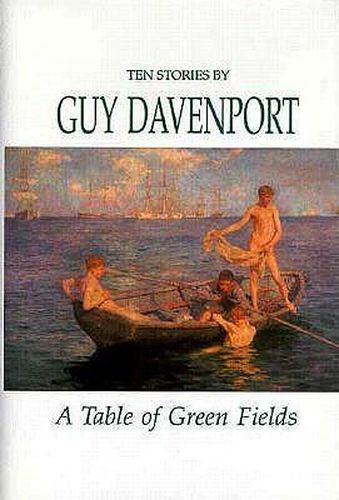Readings Newsletter
Become a Readings Member to make your shopping experience even easier.
Sign in or sign up for free!
You’re not far away from qualifying for FREE standard shipping within Australia
You’ve qualified for FREE standard shipping within Australia
The cart is loading…






A Table of Green Fields includes ten stories, variously about the painter Henry Scott Tuke, the mathematician James Joseph Sylvester, Kafka, Thoreau, along with some imaginary Frenchmen and Scandinavians, among others. Calculating the infinite in the finite, tracing geometries of desire, placing the obdurate world in an uncustomary light, each of these stories opens out its own world. Without giving up the plot or character of the traditional short story, Guy Davenport’s inventions are complex events in which ideas and cultural history are a kind of music to which the characters dance. Despite the fractal, syncopated collage of his narrative style, Davenport’s prose is objective, terse, and transparent. A constant theme in this book is the transmission of the past as an imaginative act; hence the title, Falstaff’s dying vision of a table of green fields, probably a mishearing of his recitation of the Twenty-third Psalm, corrected by editors to he babbled of green fields, a symbol of all fiction, an art that must be exact about the uncertain.
$9.00 standard shipping within Australia
FREE standard shipping within Australia for orders over $100.00
Express & International shipping calculated at checkout
A Table of Green Fields includes ten stories, variously about the painter Henry Scott Tuke, the mathematician James Joseph Sylvester, Kafka, Thoreau, along with some imaginary Frenchmen and Scandinavians, among others. Calculating the infinite in the finite, tracing geometries of desire, placing the obdurate world in an uncustomary light, each of these stories opens out its own world. Without giving up the plot or character of the traditional short story, Guy Davenport’s inventions are complex events in which ideas and cultural history are a kind of music to which the characters dance. Despite the fractal, syncopated collage of his narrative style, Davenport’s prose is objective, terse, and transparent. A constant theme in this book is the transmission of the past as an imaginative act; hence the title, Falstaff’s dying vision of a table of green fields, probably a mishearing of his recitation of the Twenty-third Psalm, corrected by editors to he babbled of green fields, a symbol of all fiction, an art that must be exact about the uncertain.